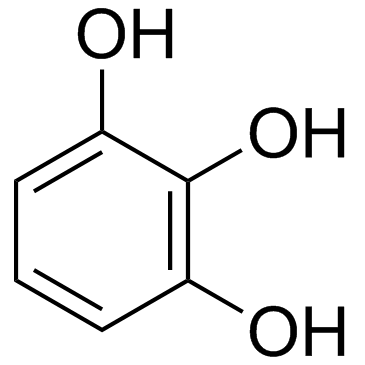Pyrogallol (Synonyms: Antioxidant PY, Benzene-1,2,3-triol, C.I. 76515, Fouramine Brown AP, NSC 5035, 2,3-dihydroxy Phenol, 1,2,3-Trihydroxybenzene) |
| Catalog No.GC32391 |
A natural oxidant
Products are for research use only. Not for human use. We do not sell to patients.

Cas No.: 87-66-1
Sample solution is provided at 25 µL, 10mM.
Pyrogallol is a polyphenol compound, which has anti-fungal and anti-psoriatic properties. Pyrogallol is a reductant that is able to generate free radicals, in particular superoxide anions.
Pyrogallol (PG) is a reductant that is able to generate free radicals, in particular superoxide anions (O2•-), so has frequently been used as a photographic developing agent and in the hair dying industry. Pyrogallol inhibits Calu-6 and A549 lung cancer cell growth via apoptosis and depletion of glutathione (GSH). Pyrogallol (PG) induces apoptosis in lung cancer cells via the overproduction of O2•- and affects mitogen activated protein kinases (MAPKs) in these cells[1]. The effect of Pyrogallol on human pulmonary fibroblast (HPF) cell viability and necrotic cell death is examined. For these experiments, 0, 50 or 100 µM Pyrogallol is used to differentiate the levels of cell viability inhibition or death with or without a given MAPK inhibitor. Treatment with 50 and 100 µM Pyrogallol decreases HPF viability by ~40 and 65% at 24 h, respectively. Treatment with an MEK inhibitor slightly enhances the inhibition of cell viability in 50 µM Pyrogallol-treated HPF cells, whereas treatment with a p38 inhibitor mildly attenuates the inhibition of viability. In 100 µM Pyrogallol-treated HPF cells, all the MAPK inhibitors increase the inhibition of viability to a certain extent, with treatment with the p38 inhibitor alone augmenting HPF control cell viability. Necrotic cell death is determined by measuring lactate dehydrogenase (LDH) release from cells. While treatment with 50 µM Pyrogallol does not affect LDH release from HPF cells, 100 µM Pyrogallol significantly increases LDH release[1].
[1]. Han BR, et al. MAPK inhibitors enhance cell death in pyrogallol-treated human pulmonary fibroblast cells via increasing O2•- levels. Oncol Lett. 2017 Jul;14(1):1179-1185.
Average Rating: 5 (Based on Reviews and 21 reference(s) in Google Scholar.)
GLPBIO products are for RESEARCH USE ONLY. Please make sure your review or question is research based.
Required fields are marked with *




















